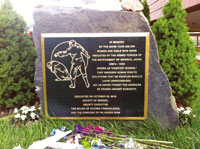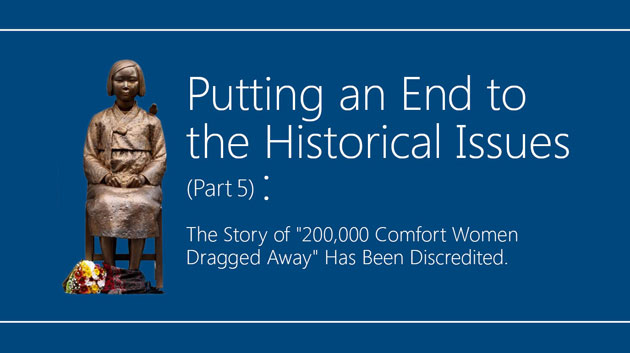Putting an End to the Historical Issues (Part 5):
The Story of "200,000 Comfort Women Dragged Away" Has Been Discredited.
Did the Japanese Army really order the forced transport of comfort women? According to the evidence over the past ten years or so, one can easily see that there has been absolutely no proof of it ever having happened.
The story, which the Korean government and Koreans living in the U.S. promoted, that “the Japanese Army forcibly transported 200,000 women and made them work as military prostitutes” has spread around the world. However, when viewed in the cool light of reason, there were many strange things about the account.
– There was no forcible transportation of 200,000 women –
- 1. No proof or evidence of forced transport by Japanese military authorities.
1. The Japanese Army in Korea remained in its garrisons.
2. The authorities cracked down on corrupt contractors who snatched women.
3. No evidence of coercion has ever been found.
4. Women, who were forced to work, sold themselves into prostitution. - 2. Despite knowing that “there was no forced transport”, did the Korean government have the Kono Statement drawn up?
1. The Korean government’s hearings provided the only proof.
2. Around 1993, Korea verified that there had been no violent transport.
3. The Korean Army actually suppressed information about their own forced transportation of comfort women.
1. No Proof or Evidence of the Japanese Military Authorities’ Forced Transport
The crux of the comfort women controversy was whether the Japanese army and authorities forcibly transported the comfort women. However, the two Japanese divisions, which were stationed in Korea to defend it against the Soviet Union, stayed within their garrisons until the end of the war. They never ventured into the towns and cities.
Kiyoshi Nishikawa (aged 97, a resident of Wakayama Prefecture) worked as a section manager in the Internal Affairs Department at the time. Mrs. Nishikawa asserted, “There was absolutely no forcible transportation. The military police kept a watchful eye on things, and there was absolutely no way that soldiers could have done something bad like snatching Korean women”.
Civilian contractors recruited the comfort women, and they acted as their intermediaries. There were cases where crooked contractors falsely claimed to be connected with the army and recruited women, but the authorities issued directives to crack down on such business practices. There continued to be cases where women were deceived, abducted, and sold on, but we know from newspaper reports at the time that the authorities for public order were zealous to expose such criminals (*1).
No proof has ever existed of the Japanese Army forcibly transporting comfort women. Neither was there any eyewitness testimony. In 1992, the Asahi Shimbun reported the finding of “a document that indicated army involvement in the military brothels”. However, this was a document that requested an investigation into a contractor that people suspected of using abduction techniques to gather women together.
In Korea, people believed that “comfort women were forced to serve as a volunteer corps”, but this has been a misconception from the very beginning. When the war took a turn for the worse, some women inside Japan worked in places such as factories as a “volunteer corps”. That was true. In Korea, however, although men were conscripted as forced labor, it was decided to wait and see if the government needed to apply compulsory enlistment for women as well.
(*1) “The Truth about Korean and Japanese History at a Glance” (by Masanori Mizuma)
Comfort Women Said “It Was Fun”
Thus, there was no truth to the story that the Japanese Army forcibly transported comfort women. Meanwhile, human rights activists have ceaselessly claimed that “there could be no doubt that the women, who were made to become sex slaves, suffered, and the Japanese government should provide them with compensation”.
Yet, testimony from the Japanese comfort women who actually went to the battle zones was very different from the frightful images the words “sex slaves” evokes.
In “Testimony and Documents: Comfort Women and Nurses” (by Kazuko Hirota), Kaoruko Yamauchi, who was a comfort woman on the Pacific island of Truk, reminisced, “The most fun I ever had was when I was on Truk Island”. She testified about her life there as follows:
I was for the use of officers. I was able to eat the same food as the men that I entertained. (…) We didn’t have to do anything at all since the Kanaka servants would heat up the baths from six in the morning and prepare our meals.
Female contact was precious to the soldiers, and they valued their comfort women. For example, cases even existed where they brought them souvenirs and proposed to marry them. However, many suspicious elements existed in the testimony of the Korean ex-comfort women that suggested they were abused.
Kenjiro Ando (aged 94, a resident of Hokkaido), who used to be a member of the Flying Corps, agreed to go on record for an interview for this magazine:
Female contact was precious, and we all valued the comfort women so there was no way that anyone would have behaved so shamelessly as to hit them. They were like comrades in arms to us, encouraging us to do our best.”
There were detailed regulations for the use of military brothels, and anyone who caused trouble was banned. Although there were no doubt some soldiers who behaved badly, it was a distortion of the truth that “the Japanese Army systematically assaulted and raped comfort women”.
The truth is that the comfort women were “registered prostitutes” that collaborated with the soldiers and earned upwards of 300 yen a month, which was as much as four times the salary of a university graduate at the time. Many of them earned more than the generals, and some of those women amassed fortunes.
It is true that many of them came from poor families and had no choice but to become prostitutes. Many of them and their families got advance payments from the contractors, which the comfort woman then worked to repay. In other words, women, who sold themselves into prostitution, did exist in the Japan of that day. This is the reality of what is called “coercion in the wider sense of the word”, and some people do call for compensation from the Japanese government. Yet, however unfortunate their circumstances might have been, the Japanese government cannot be said to bear any liability since there was no direct coercion from the government that forced those women into their occupations.
2. Despite Knowing That “There Was No Forced Transport”, Did the Korean Government Have the Kono Statement Drawn Up?

A monument to the comfort women built in New Jersey, U.S.A. Groups of Koreans residents in America are erecting similar monuments throughout the country. They are pushing Congress to adopt a resolution on the comfort women.
It is clear that the story of the forced transport of the comfort women was an error, but opinion makers have suspected that, even though the Koreans knew that the story was a lie, the Korean government used this historical issue as a card to play in diplomatic cirlces.
The particulars, concerning the issuing of the Kono Statement, suggest a crime of conscience. In the statement, Japanese government officials apologized for the authorities’ coercion and recruitment of the comfort women. Yet, the original Japanese government investigation found not one scrap of proof that revealed that kind of compulsion. Only interviews with former comfort women substantiated the stories, and the Korean government originally requested the old women to speak. The interviewees, 16 former comfort women that the Korean government selected, were people who completely lacked objectivity. The hearings were, in other words, artificial in that they did not permit such things as cross-examination from the Japanese side or background checks of the parties involved.
The details of the hearings still have yet to be released. An educator named Nobukatsu Fujioka said in an interview;
If they were released, background checks would be run and discrepancies would be discovered. The Japanese government has actually been shielding the former comfort women. No doubt, there was a secret agreement with Korea.”
The Korean government put constant pressure on the Japanese to acknowledge and apologize for coercing the comfort women. They persisted in doing so even though they knew it was not true.
In “Comfort Women and Battleground Sex”, the contemporary historian Ikuhiko Hata stated, “It is thought that between the autumn of 1992 and early 1993, the Korean government arrived at the belief that there seemed to have been no forced transport.”
In fact, The Korean Council for Women Drafted Into Military Sexual Slavery by the Japanese compiled evidence from the conducted hearings with the former comfort women, and published their findings in February of 1993. The Korean Council wrote, “None of the military documents, discovered so far, provides a detailed explanation of how the comfort women were drafted”(*2).
(*2) “Comfort Women and Battleground Sex” (by Ikuhiko Hata) etc.
Korea Should Confront Its Own Historical Issues
It is now evident that the Japanese “comfort women issue” was not based on fact, but the Korean “comfort women issue” is still receiving attention from the public.
A military document called “War History on the Home Front” proved that the Korean Army financed and ran military brothels during the Korean War. There were 89 comfort women, registered as “Class V supplies” in brothels at four locations, which included a site in Seoul. 200,000 sexual encounters apparently took place in one year.
However, unlike the contractors’ supply of Japanese comfort women, in some cases they were women who were suspected of being communists. They were forcibly brought to the brothels. There were also accounts of soldiers, who pushed women into storage drums, and drove them away in trucks (*3).
(*3) “The Story of the Republic of Korea: Let Us Rewrite the National History Textbooks” (by I Yonfun)
Professor Kim Ki-ok of Hansung University publicized this issue in an academic paper in 2002, but immediately after its publication, the related documents in the National Defence Department’s reference room were placed out of bounds. The regular mass media has remained indifferent, and the professor has even encountered criticism in the form of questions regarding whether she was trying to profit Japan. (*4)
(*4) “Troops and Sexual Violence: The Korean Peninsula in the 20th Century” (edited by Son Yonuk and Kaneshige)
This episode wasn’t the only example of Korean double standards. They have sought compensation from Japan for other areas, and at the same time, they’ve also tried to cover up their other historical issues. Korea dispatched 320,000 troops to the Vietnam War where they massacred 300,000 Vietnamese civilians. According to a field survey from the community-based organization Nawauri, in one village after another, the Korean Army rounded up unresisting villagers to machine gun them down and set fire to the communities (*5). There were many cases of rape, and as a result, as many as 30,000 children of mixed blood were born. Yet, Korea never paid any compensation to Vietnam.
(*5) “Memories of War, War of Memories” (by Kim Hyona)
In its diplomacy, Korea has been playing “the forced transportation of comfort women” card. Even though the Korean government knew the story was a lie, they still have been trying to fool the Japanese. That’s the truth of the situation with regard to the comfort women issue. The Kono Statement was groundless. It damaged people’s trust in Japan, and the statement should be invalidated immediately.
Related
- Putting an End to the Historical Issues (Part 4):
- Removing the Historical Issues Caused by the Kono and Murayama Statements: Incorrect Perceptions of History Continue to Degrade Japan.
- Putting an End to the Historical Issues (Part 6)
- “Were the Experiences of Comfort Women So Real That They Would Swear it Under Oath Before God?”
- An Exclusive Report That Puts an End to the Controversy Over the Nanking Massacre and Comfort Women



















